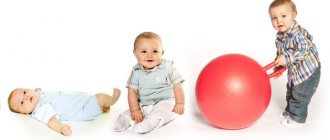Time frame for skill formation
The chewing reflex in children should appear even before the transition to solid food (this is usually recommended after 12-18 months).
The first attempts in babies appear around 6 months (sometimes earlier); at this stage of their development, the child diligently puts his hands and various objects into his mouth, trying to chew them. This way he not only scratches his gums (this period usually coincides with the eruption of his first teeth), but also trains his ability to chew.
After some time, the instinct may fade, since the first few teeth will interfere with chewing movements. However, a one-year-old child again begins to show interest in adult food, and the task of parents is to develop it.
Stages of formation of the chewing reflex
Many people think that the skill of chewing appears only when the first teeth appear. This is not so, the chewing reflex develops earlier and already at this time it is necessary to accustom the baby to solid food. The most important thing is not to miss the moment when the child begins to put everything in his mouth, and his chewing reflex begins to develop. The first signal that the baby is ready to chew on his own is itching of the gums, which many equate with teething. This period occurs in children at different times, for some at 4 months, for some babies only at 7.
Conventionally, the stages of the chewing reflex are divided into three periods:
- 6-12 months. At this time, complementary foods are introduced, children move their jaws and lips, developing a chewing reflex. From 8 months it is allowed to give food with small lumps.
- 1-2 years. By the beginning of the second year, children have an average of 6-8 teeth, which means they can be offered chewable foods. Many mothers, due to inexperience, think that giving a child up to 12 months solid foods is not worth it; this is incorrect and thanks to early training, they will be able to train the chewing reflex.
- 2 years. At this time, the preschooler should chew food well, including meat.
If you miss this time, the child will refuse food even in kindergarten, since he is not used to making an effort. He will, of course, learn to chew, but it will be very late.
Why doesn't my child chew at the right time?
There are many reasons for the absence of a chewing reflex in children 2 years of age and older.
Some of them are easy to correct with some effort, others may be pathological. Reasons for the absence of the chewing reflex:
- Early completed breastfeeding, mixed or artificial feeding from birth.
It has been proven that children who feed exclusively on breast milk have a more developed jaw apparatus, master speech earlier and do not experience difficulties when switching to solid food. The fact is that in order to obtain milk from the mother's breast, they have to make great efforts, straining their tongue and other muscles. Children receiving formula are accustomed to easy access to food.
- Improperly organized feeding.
The child’s diet should be compiled according to the schedule developed by pediatricians. It is recommended to introduce food chopped into pieces after 9 months, but no later than a year.
Naturally, after liquid cereals and purees, babies have a hard time accepting this type of food: they spit it out, swallow pieces, or refuse to eat at all. Caring and loving parents strive to feed their child, so they continue to grind food with a blender for a long time.
The child gets used to not making an effort to eat, so at 2 years old he continues to eat puree from jars. The same can be applied to parents who have little free time to teach their baby to chew in time.
- Lack of devices to facilitate teething in the first year of life.
In this case, the baby loses the chewing reflex completely by one year.
- The laziness of a child, which appears due to the indulgence of his parents to his whims.
The baby begins to cry when he receives solid food, and the mother immediately gives him puree.
- Abrupt transfer of a child to solid foods.
This process causes stress in children, and they categorically refuse any food.
- Excessive activity of the baby.
Such children are constantly on the move and get used to eating very quickly, which is impossible to do with solid food.
- Introducing complementary foods later than expected (after six months).
The baby gets used to drinking formula from a bottle or milk from the mother's breast.
- Diseases of the digestive tract, inflammation in the mouth or larynx.
The reason that the baby cannot chew solid food at the right time may be deviations in physical development or weakness of the facial muscles. Children with such problems are not uncommon today. This is due to a poor environmental situation, genetics, nutrition and lifestyle of expectant mothers, or complicated childbirth.
Is it so important for a child to be able to chew solid food?
In fact, the ability to chew at 1-2 years of age is inherent in nature and contributes to the formation of:
Lack of load on the gums reduces the activity of blood circulation, teeth grow weak, an incorrect bite may form and dental problems may begin in the future.
Oddly enough, it is the chewing reflex (as well as sucking a woman’s breast) that trains the baby’s articulation. If a child has problems eating solid food, this also affects his speech; he may simply not pronounce some sounds.
During the chewing process, food is moistened with saliva, which triggers the process of enzyme synthesis and improves digestion.
In addition, children who do not learn to chew in time risk growing up as psychological manipulators; it will be difficult for them to navigate the children's group.
Prohibited products
To avoid food allergies, digestive and dental problems, a child under four years of age should never be given:
- lollipops, caramel, toffee
- nuts and any seeds
- any hard cheese
- tough pieces of meat
- whole grapes
- large pieces of hard vegetables and fruits
We recommend reading: Cabbage juice for stomach ulcers: how to take it, will it help cure an ulcer
In addition, the children's diet should not contain honey (a very strong allergen) and mushrooms (which can cause problems with the gastrointestinal tract).
How to teach a one-year-old child to chew
Today, more than half of children do not know how to chew by the age of 2.
You need to develop this skill from six months:
- Buy beautiful teethers (several types).
The child must not only relieve tension from the gums, but also learn to chew. The main thing is to remember to keep them clean and wash them regularly.
As an introduction to food, instead of a teether, you can give a small bagel, a piece of carrot, or an apple. In the process of chewing with the gums, the baby will receive small pieces of treats. So the baby will understand that you can get a new taste on your own.
At the same time, parents should not leave their children unattended. The bagels are quite fragile, they can crumble, small pieces can block the respiratory system.
A special device with a plastic (silicone) mesh, inside of which you can place pieces of fruits and vegetables. The nibbler will allow the child to get acquainted with new tastes and at the same time retains the pieces, so it is safe for the baby.
- Gradually introduce new foods.
You should not suddenly start feeding your child soup, like adults. Part of the usual food should be replaced with chunks, for example, leaving a few small pieces of potatoes in the mashed potatoes or decorating the porridge with fresh fruit.
There is no need to give your baby large pieces right away; you can chop the food using a grater, a knife, or simply mash it with a fork. This does not apply to meat products: a child may not be able to chew the fibers and may choke. It is better to offer him a soufflé or steamed cutlets and meatballs.
Typically, these measures are enough for children to fully master chewing skills by the age of one and a half years.
You can learn more about how to teach your baby to chew solid food in different ways by watching the video.
Urgent measures
Unfortunately, some children cannot eat solid food even at 2-3 years old. First of all, such a child should be shown to a pediatrician to exclude possible pathologies.
There are several ways to teach children to chew after 2 years of age:
Start by preparing simple dishes and let your child take part as much as possible. Sit down at the table with the whole family, put the food on beautiful plates (everyone has the same one).
Show your baby how to chew in a playful way; you can arrange a competition.
The main thing is to remain calm, do not be too strict and do not scold, and even more so, do not punish for failure.
- Invite children over.
Or older or peers who have already mastered chewing skills. Looking at them, it is likely that the baby will begin to repeat.
- Eliminate pureed foods from your diet.
Encourage your child to chop vegetables or fruits themselves. Most likely the baby will not have the strength to do this on his own, help him.
- Using soft and tasty products.
For example, natural marmalade or marshmallows. They are very easy to chew, and the taste is much more pleasant than regular food.
- Do not use a blender. You could say he was broken.
- Leave tasty snacks in a visible place: bananas, sliced apples.
- Master acting skills.
When can a baby be given solid foods?
Solid foods should be introduced at 5–6 months of age. The starting point for instilling a skill is considered to be a noticeable secretion of saliva. From this point on, the gums prepare for teething. The baby puts everything that comes to hand into his mouth. Including your fists. Replace them with useful devices, the baby will train profitably. For chewing, offer:
- Drying, cracker. Change them constantly so that the child does not choke on a piece of the chewed treat.
- Teethers. The option with water inside is the most effective and convenient. The child will gnaw and thoroughly chew the chilled toy with great pleasure.
- Nibbler. A modern version of gauze with a carrot or apple inside. This device is a pouch. A solid tasty treat is placed in it. The baby gnaws the nibbler, crushes the fruit, and sucks the juices out of it. Eats and scratches gums at the same time.
When organizing training for the masticatory apparatus, it is important to maintain regularity. Offer your young child something to chew on every day. If he refuses, insist, but in moderation. In case of hysterics and complete rejection of teethers, nibblers, take a break for 2-3 days, then try again.
When the baby has mastered chewing hard objects, start feeding him pieces of soft cookies and fruit for an afternoon snack or lunch. Give a little at first, then offer to bite and chew on your own. But never leave a toothless baby alone with a large cookie; he may choke after biting off and swallowing a huge piece.
Thus, having started training for a positive perception of solid food at 6 months, mothers will have good chewing babies in about a year. If you start later, the process will be delayed.
How to teach a child to chew - advice from a speech therapist
Write an article “How to teach a child to chew?” I, a speech therapist of the highest category with considerable experience, was prompted by observations in recent years of 3-4 year old children who - as strange as it sounds - do not know how to chew. Just a few years ago you could laugh: “A child cannot chew at 3-4 years old? This can’t happen!” But I myself had to face this problem many times. Children came to kindergarten at three years old and could not eat anything there. Parents brought mashed potatoes in jars or the teacher “kneaded” the first dish. Moreover, consultations with a neurologist did not give anything - the answer was: “He’ll watch how other children eat and learn on his own.” They didn’t learn by imitation, they weren’t given food to an adult, they spat and choked. Below we will highlight the causes of this problem and practical recommendations for overcoming it.
Negative results of not knowing how to eat solid foods:
Food is not sufficiently saturated with saliva and does not mix with it, which means that gastric juice and digestive enzymes are poorly produced;
The muscles of the tongue do not develop, which prevents the formation of correct pronunciation of speech sounds;
The teeth do not experience the necessary load (they may fall out prematurely, or an incorrect bite may form).
On the Internet, the forums of numerous sites for mothers are replete with the question: “How to teach a child to chew?” Some people come to their senses at 1.5 years old, while others constantly use a blender to prepare food for their three-year-old child. This problem is becoming more common. “Thank you” to our pediatricians. They too persistently implement Decree of the Government of the Russian Federation of March 21, 2007 No. 172 and the approved federal target program “Children of Russia,” which encourages mothers to breastfeed. Indeed, the trend in recent years in pediatrics is priority breastfeeding. At the same time, modern pediatricians advise young mothers not to rush into introducing complementary foods, explaining that this is fraught with allergies to foods new to the child. At the same time, even the latest edition of the recommendations of the World Health Organization (WHO) notes that the appearance of the first chewing movements reflexively in children occurs at 4-5 months (at the same time, the child experiences a movement of the gag reflex from the middle to the back third of the tongue). But parents, on the doctor’s advice, are in no hurry to introduce complementary foods. Thus, the reflex, not supported by practice, fades.
At 7-12 months, according to WHO recommendations, the child develops biting and chewing skills, develops lateral movements of the tongue and moves food to the teeth with the tongue. At this age, the child is already able to eat porridge and chopped fruits and raw vegetables. By the age of one or two years, the child already eats food from the family table. So, if a few years ago a baby at 4-5 months (before the appearance of teeth) received from his mother or grandmother dry bread, crackers or even a fresh boiled chicken bone and “learned to chew” with his gums. Today, mothers, acting “according to science,” introduce complementary foods after 6 months (or even later), when the child already has 2-4 front teeth. These teeth are used for biting; it is impossible to chew with them, but what is important is that they prevent the baby from chewing with his gums. In this case, all that remains is to wait for the appearance of a full set of molars and teach them to chew with them. From about one year of age, the baby can gradually begin to eat solid foods and learn to chew small pieces.
But what to do if the moment is missed, if the child is already accustomed to pureed food and chokes on any piece that gets into the mouth after two years? There is no method for teaching chewing. But in this process two aspects can be distinguished: physiological and psychological. Next, I will give practical recommendations (from work experience) for children to master the chewing process.
1. Activation of the tongue muscles and overcoming the gag reflex. It is effective to use a gentle massage of the tongue through a gauze cloth, as well as using a wooden spatula (with gradual advancement to the root of the tongue); pushing out a gauze pad placed deep behind the cheek with the tongue. In parallel with the massage, it is useful to carry out articulation exercises.
2. Overcoming the fear of putting solid food in your mouth. Our grandmothers gave babies a piece of apple wrapped in gauze. The baby chewed on this piece, but the mother was not afraid that the child would choke after taking a bite. And the child felt the taste of an apple, developed chewing movements, and trained salivation. (USA) offers parents an improved form of “gauze with a piece”. The product is called “Nibbler” (feeding strainer). Using a special strainer with a handle, a child can safely eat fruits, vegetables and learn to chew. A piece of fruit or vegetable is inserted into a special mesh. Through the small cells, the baby will not be able to bite off a piece; only the smallest particles of the product, safe for swallowing, will enter his mouth.
3. Gradual transition from pureed food to “pieces”. Little by little we offer not food pureed in a blender, but food with small “pieces”. Then the food, crushed with a fork. You can use a psychological trick: suddenly “the blender got lost somewhere” (broke). And then invite the baby (“you’re already big”) to chop the food on his plate with a fork. Since, in the end, it is easier for a child to put a piece of potato in his mouth than to crush it with a fork, chewing will win.
4. Inducing the desire to eat solid food by imitation. You need the whole family to show your baby that eating is interesting and exciting! You all sit down at the table together, DO NOT CALL the child to the table (you deliberately ignore it) and begin to eat with a huge appetite, praising and admiring how incredibly delicious everything is! Thus, the baby is interested in the process of eating. If the child comes to the table, there is no need to rush to seat him at the table - on the contrary, you send him away: go play, we are eating, we have a very important and interesting business, no one pushes food on the child. Invite guests and go visit yourself. Your behavior should be such that the child understands that he has missed something in life, something that turns out to be very interesting!
Please note that after two years it is quite difficult to arouse a child’s interest in food; the concept has already formed - so you should not expect quick results. The baby will not immediately run to the table. You need to wait for him to show sustained interest - and only then let us try. If you see that interest is waning, that’s it, go play. As soon as you start insisting again, the child’s interest will immediately disappear.
Do not leave your baby unattended with food. But there is no need to persistently “observe.” Otherwise, the child will begin to look for some kind of danger in the process of eating solid food and will again begin to choke.
How to teach a baby to chew: effective methods
Introduction to solid foods
Let's start with the fact that you need to switch to solid food gradually. If you use ready-made mixtures and purees, then choose only those products that are appropriate for the child’s age. The older the baby, the thicker the mixtures will be, and fruit, meat and vegetable purees will begin to contain solid pieces of food.
If you are used to feeding your baby homemade foods, then you can begin the transition to solid food by gradually reducing the degree of grinding and abandoning the blender. Some of the food can be crushed with a fork, and some can be grated on a coarse grater.
But what to do if the right moment is missed, the child is already too accustomed to ground food and categorically refuses to chew and swallow even small pieces?
Tongue massage
Start by activating the muscles of the tongue, which is necessary in order to prevent the baby from developing a gag reflex when solid food gets into the mouth. To do this, gently massage your child's tongue every day using gauze and a wooden spatula, trying to get closer to the root of the tongue day by day.
As an option, you can also invite the baby to push out a gauze napkin placed behind the cheek with his tongue. It will be great if, along the way, you introduce articulatory gymnastics into your child’s life.
Using a nibbler
To help your baby cope with the fear of putting solid food in his mouth, you can start with fruit wrapped in gauze or use a more modern device - a nibbler - a feeding sieve.
A nibbler is a small pacifier-shaped sieve with a handle into which a piece of fruit or vegetable is placed. A child will be able to train chewing reflexes by simply chewing fruit in a nibbler without the risk of choking on a large piece.
Involving your baby in the cooking process
You can try to prank a child after one year old by convincing him that the blender is broken, so he will have to choke the food with a fork. An excellent effect can be achieved if you involve your baby in the cooking process - let him crush the potatoes with a fork or grate the carrots.
Perhaps in this case he will be more willing to try the fruits of his labor.
Positive example
It is very important to demonstrate to your child as a family that eating pieces of food with a fork is fun. Start by setting the table, invite all family members to it, deliberately ignoring the child.
During meals, focus on how tasty and convenient it is to eat solid food, thereby awakening your baby’s interest in what is happening. Let him sit down at the table only after he is very hungry.
Invite guests more often, go on a visit with your child, and be sure to focus on eating “adult” food. It is important to let your baby know that eating this type of food is fun, even if it takes a long time.
How and when should you teach your baby to chew?
Young mothers are often puzzled by how to teach their child to chew, and worry if their baby cannot eat a piece of apple or cookie on his own.
The women's website “Beautiful and Successful” dedicates this page to women who are worried about the development of their children. Today he will try to answer as fully as possible all the questions regarding the development of the chewing reflex that interest them.
Chewing reflex: when is it formed normally?
Small children are born with reflexes, one of which is sucking. The baby does not need to be taught this: he will suck any object that gets into his mouth. Until about four months of age, the baby will reflexively push any solid food out of the mouth with its tongue.
That is why it makes no sense to introduce complementary foods before 4 months of age. Children who have already reached this age can gradually introduce simple foods into their diet. First you need to start teaching your baby to eat food in the form of gruel or puree. For this dish you need to grind it in a blender. The ability to swallow cereals and purees is the basis for the formation of a chewing reflex.
The website sympaty.net emphasizes: chewing is precisely a reflex that develops after the sucking reflex and is provided by nature as a vital skill.
When should a baby normally learn to chew? In each individual case, the answer to this question will be different.
However, in any case, it will be associated with the physiological development of the baby: the baby will not learn to chew on his own until most of his teeth have erupted.
When the baby has chewing tools, he must learn to use them. For most children, this period begins after one year. At the same time, the chewing reflex will not be able to develop in a baby who does not need it. This happens when an overly caring mother, even after a year, continues to carefully grind the baby’s food in a blender and feed him liquid porridge from a bottle.
What needs to be done to teach a child to chew and swallow solid food correctly? If we answer this question briefly, we can say in one sentence: it is necessary to feed the baby solid food. Let's consider this issue in more detail.
What to do if your baby is choking?
Even in cases where parents did not miss this moment, knowledge of how first aid should be provided is necessary. Only in a calm and focused state can you find the right solution.
Helpful: Why does a newborn have trouble sleeping at night?
The human body is often able to help itself. That is why when a foreign body enters the respiratory tract, coughing and even vomiting begins. With their help, the ill-fated piece is pushed out, and breathing is normalized. Therefore, if a baby chokes on food and coughs, this means that there is enough air coming in and there is a high probability that the object will come out on its own. But this may not happen if it is quite large. In this case, you need to call an ambulance. While waiting for the doctor, try to calm the baby down, lay him on his side with his chin raised. The baby should move as little as possible, since his movements may cause the piece to change location. It is also better not to try to get it out on your own, as there is a risk of pushing it deeper.
It is necessary to act immediately if the child:
- chokes and gasps for air;
- grabs himself by the neck;
- he can't cry;
- the skin turns blue.
In such cases, first aid must be provided without fail, because five minutes are enough for irreparable consequences. It is better to call an ambulance to someone else or only when the baby is not suffocating.
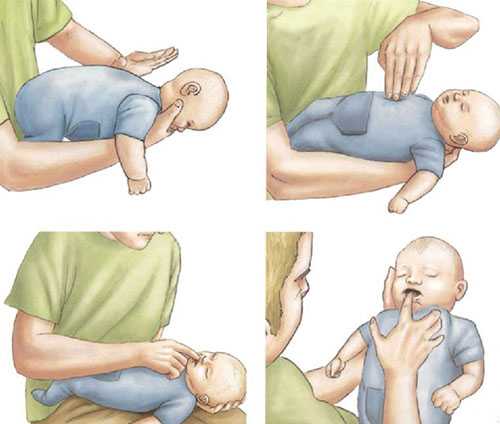
Why teach a child to chew?
Our great-great-grandmothers did not ask questions about when and how to teach children basic skills. They simply tried to teach them to be independent from the very cradle, while carefully observing the changing needs of the baby. Babies began to be fed pieces of fruit and berries even before they had teeth. No one crushed these products on purpose. They were simply placed in a kind of nibbler made from a piece of linen fabric. The baby sucked on the treat as best he could, learning to swallow pieces the size of bread crumbs.
Adult dishes were introduced into the diet of babies around the age of one year. So that the baby could swallow it, soups and cereals were crushed through a sieve. At first the food was ground quite finely. Then, each time the pieces in the dish became larger. This helped him gradually get used to the new consistency of food and swallow fairly large pieces. Adults tried to gradually teach the child to chew food and swallow it, because they wanted to make him independent as quickly as possible.
At the same time, the need to chew arises in children not only as an indicator of his independence. Chewing is extremely important for a child's health and development. The load on the gums improves blood supply to them, making the teeth stronger.
The benefit of chewing also lies in the fact that when food is thoroughly ground in the mouth, it is moistened with saliva and is better digested. When chewing foods, the baby remembers their taste, which contributes to the development of his taste preferences in the future.
Chewing solid food promotes the development of the articulatory apparatus. It has been noticed that children who do not chew on their own for a long time always face pronunciation problems. Therefore, it is very important that the baby begins to chew on time.
When should you teach your baby to chew and swallow solid food?
Pediatricians say that children do not need to be taught to chew. This is a reflex that develops on its own if you don’t interfere with it. Therefore, it is more correct to ask the question not how to teach a child to chew solid food, but when to start stimulating his chewing reflex.
This should be done by about a year. At this age, most babies already have 8-10 teeth, which allows them to grind pieces of food. If at the age of one year the baby has only 2-3 teeth, it is too early to give him something to chew.
How exactly?
The following techniques will help teach a 2-3 year old child to chew:
- Stimulate interest in independent chewing. If a baby at 9-12 months wants to suck on a piece of apple himself, the mother does not need to take the fruit away from him to grate it on a fine grater. It would be more correct to cut off the skin from the fruit and make sure that the baby does not bite off too large a piece.
- Teach your baby to eat according to a schedule. Very often, parents who complain about their children’s lack of appetite and interest in food are themselves to blame for this, because they have not organized a regular diet. Pediatricians assure that when parents teach their baby to eat on a schedule, then his appetite will significantly improve.
- Keep your baby interested in eating with a spoon on his own. In order for the baby to start eating on his own, you should not force him to do it. Any coercion kills children's interest in action. You can give the baby a spoon in the hand during feeding. While the mother feeds the baby, he will stir the porridge or puree. Gradually, he will develop the ability to put a spoon in his mouth, and he will begin to eat without his mother’s help.
- Offer your baby dishes in which the food particles will gradually become larger and larger. If it is better for children under one year of age to give food crushed to a homogeneous consistency, then with age it is necessary to grind the food less thoroughly. At the age of 2 years, girls and boys should already be able to chew and swallow cereals, vegetables, fruits, and meat. If at this age a child is still choking on solid food, it means that the parents made a mistake in raising him.
- Give the baby hard dryers so that he scratches his gums. When the baby's first teeth appear, you can already offer him to scratch his gums with a hard baked product: this will help relieve discomfort from itching and introduce him to the taste of drying.
- Do not show your fear if the baby starts choking. In such a case, you just need to help him while remaining calm. As a rule, when too large a piece gets into the mouth, the child’s protective gag reflex is triggered, so the particle does not reach the throat area. In this case, you can remove excess food from the baby’s mouth with your index finger.
An invitation to a common table will also help teach a baby to chew independently. Seeing how adults eat, the baby will imitate them, trying to independently bite off pieces of bread, vegetables, fruits, cutlets, and meatballs.
For some children, interest in adult solid food does not awaken for a long time. Of course, if a 2-3 year old child does not want to eat on his own, this is a problem: after all, soon he will need to go to kindergarten, and there all the pupils eat themselves. At the same time, it is in kindergarten that many children begin to imitate their peers and eat without the help of adults. Teachers of preschool institutions say that in a team, children learn the necessary skills much faster.
The problem is that not a single mother wants her child to be taught basic things in kindergarten, so she tries to develop all the skills herself. To make the learning process go faster, you need to take into account a simple truth: excessive parental care harms the independence of sons and daughters. If the child has not yet learned to eat on his own, you need to stop constantly helping him, performing instead actions that he can do himself.
Tips for parents
Fathers and mothers of babies who are just making their first independent attempts to chew food should carefully monitor how the child does this. In order for the process of learning to chew to occur most effectively, parents should pay attention to the following tips.
- Try to set an example for your child. Children unconsciously copy the behavior patterns of their parents. In order for your child to quickly adopt the habit of chewing solid food, try to eat with your baby. The child will pay attention to how mom or dad chews food, and will unconsciously copy it and try to repeat it.
- Do not introduce food containing large pieces of vegetables too early . First, you should “accustom” the child’s body to liquid, pureed food, and then gradually to puree. Only by the 9-10th month of the child can you gradually change the consistency of dishes.
- Keep track of feeding times. Many mothers are faced with the fact that the child begins to choke while eating, especially when eating solid food. Very often this is caused by rushing to feed. In order to chew food with large pieces well, the baby needs a sufficient amount of time. You should not give your child the next spoonful of food if he has not chewed the previous portion properly.
- Praise the child. A child who feels care and love from his parents learns more easily. Child psychologists who work with children always talk about this. If a child tries to chew, then parents should definitely praise the baby for his diligence.
We recommend reading: Suprastin and alcohol: compatibility and consequences
Methods of teaching chewing have changed over time. So, our great-grandmothers, in order for the baby to start chewing solid food faster, gave him a small piece of apple or even bread. Typically, such “complementary foods” were given to a child when his teeth began to “itch.” It was believed that if a child sucked on an apple or a piece of bread, he would sooner learn to chew independently.
Gadgets and various devices come to the aid of modern parents. One of them is nibbler. It is a special device, most often made of silicone, into which you can place a variety of goodies - pieces of apple, banana or children's cookies. Manufacturers of nibblers note that such devices help babies begin to chew solid food much earlier.
Doctors note that timely teaching a child to chew also contributes to the good development of the gastrointestinal tract. During the chewing process, saliva is formed in the oral cavity, which contains important enzymes that improve digestion. Food that is well processed by saliva is better digested, which contributes to the baby’s good health.
Chewing also has a positive effect on the development of the masticatory muscles. Many parents notice that as soon as the child has teeth and begins to chew, the proportions of his face begin to change. The contour of a child's face changes, which is due to the fact that the masticatory muscles become more developed every day. Gradually, the contours of the child’s cheekbones appear.
Interestingly, speech therapists also note the importance of timely chewing. These experts argue that children who start chewing solid food early enough have fewer problems pronouncing various sounds and then syllables. A well-developed oral apparatus helps the child cope with the pronunciation of the first words.
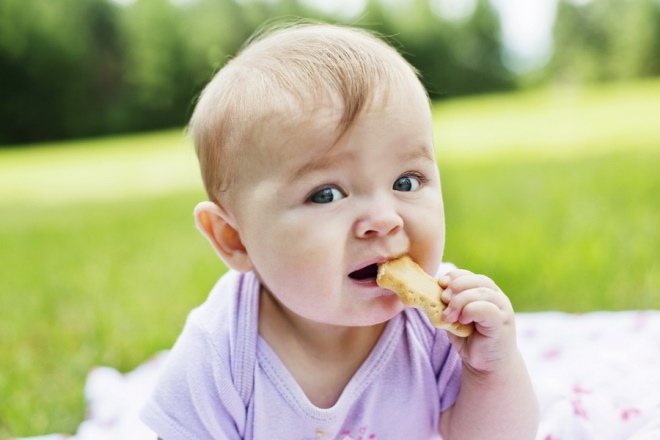
Teaching a child to chew
The time comes when complementary foods are introduced into the child's diet. This is the period of transition from feeding on breast milk or formula to food that everyone eats. At this time, it is worth paying special attention to ensuring that the consistency of the food offered to children corresponds to the development of the chewing apparatus and the ability of the digestive system to digest the products offered.
Compliance with this principle will help in teaching children to eat healthy and will promote proper digestion throughout life.
Due to the relevance of the topic, parents always have many questions. How do you know when your baby is ready to eat solid food? When should I start introducing it? What is the procedure for transferring children to the common table?
The skill of chewing must appear before we begin to teach the child to eat independently with a spoon.
Useful recommendations will help adults understand all the issues of concern, which will have a beneficial effect on the future health and lifestyle of children.

When should your baby start chewing?
Quite often, parents begin to pay attention late to the fact that their children refuse solid food and do not chew it at 1.5-2 years. They have to grind and mash their food before they eat it. This is not normal at this age. Usually mothers are very worried. What's the matter?
Maybe the baby has an underdeveloped chewing reflex? Then how to teach him to chew food properly? There are many questions, and to get answers to them, we will understand the structure of the child’s body.
The development of the chewing reflex in children must be taken care of in advance. Measures must be taken from the age of six months. They begin to be given dry foods, crusts of bread or a special teether. When scratching the gums, chewing movements are made.
The baby must acquire and develop the skills of chewing food before the moment when his teeth erupt. Once the teeth appear, it will be very difficult to correct the situation.
When children are one year old, they already have the necessary number of teeth to eat solid foods. During this period, it is necessary to teach the little man to swallow, suck and chew. If you waste time, you may end up with your child demanding only thin porridges and purees.
If it is difficult for a child to swallow chewed food, for example, he eats pasta, offer to wash it down. There is a separate article on drinks for children on our website.
By the age of two, children are definitely able to chew solid food well. If you notice that this is not happening, you need to urgently take measures to correct the situation.

Otherwise, you may experience improper development of teeth and jaws, impaired salivation, problems with the digestive system, and the development of various infections in the oral cavity.
Before you begin to correct the situation, it is worth establishing the reasons for the current situation.
When does a child begin to chew independently?
A child's chewing skills begin to develop from the moment the first teeth erupt: he begins to actively put into his mouth everything that comes into his hands. It is necessary to take advantage of this moment and make the process of chewing and getting used to new solid food exciting for the child.
You need to know how to accustom a child to solid food if he has previously received nothing but pureed purees and cereals. Many parents believe that the child will eventually learn to do this on his own. But if the baby is fed only pureed and soft foods during the period of teething, this may later result in problems in his development and formation.
Children under one year of age should be taught and taught to chew solid food. This will further help to form a correct bite, a good digestive system and develop the facial muscles responsible for speech function in a small person.
Reasons for reluctance to chew food
There may be several reasons for children's reluctance to chew food. Some of them are easily eliminated, while others require the intervention of specialists. Let's look at the most common ones:
1. Children receive improper nutrition. There are a lot of cases when a mother takes excessive care of her child, constantly chopping and crushing food for him. It turns out that she does all the work for the baby. He must try to chew himself and learn it constantly.
2. The baby has not yet developed the skill of chewing solid food. This happens due to the fact that his parents did not previously give him hard crusts of bread, dry bread and teethers.
3. Children are naturally lazy. They just don’t want to chew on their own if their mother also chops everything up.
4. Increased activity can also cause reluctance to chew food. Such children are constantly spinning around, rushing somewhere, and cannot sit still. They don’t even want to chew, because they “don’t have time.”
The main task of parents is to identify the reason for the reluctance to eat solid food. Only in this case will you be able to help him acquire the necessary skills.
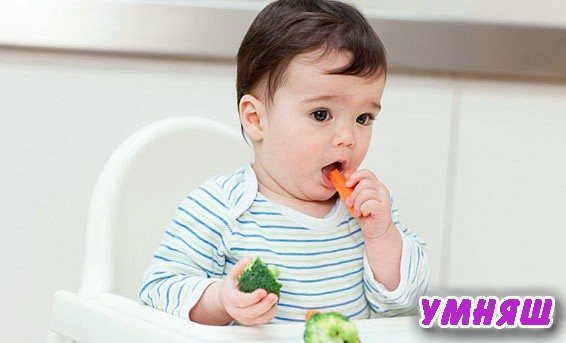
After introducing complementary foods, parents will have to go through another exciting quest and find out when to potty train their child and how to do it correctly.
How to teach your baby to chew
So, how do you teach your child to chew solid food? Parents can achieve positive results only when they are methodical, calm and patient. This is the main thing.
What to do, basic recommendations:
1. It is necessary to show children by example how to chew . Buy something tasty and explain that it can only be eaten by chewing.
2. Stop chopping and grinding food . Give babies only hard pieces. If you don't want to eat, leave him alone for now and don't scold him. He will still start eating if he gets hungry. We need to be patient.
3. There are no special methods to teach children to eat solid foods. Parents should explain this . They trust mom and dad, so they will listen to them and repeat what they do.
4. Create a bright assortment of boiled vegetables on the little person’s plate . Show that they are very tasty by eating them with him. The baby will like the bright colors, he will be interested, and will eat vegetables too.
5. If you feed your child with baby food (jars of puree), then you need to buy them according to his age , and move on to the next step in time. Baby food is produced in different consistencies and is divided into stages according to age.
6. From six months it is worth giving drying , he will first bite it with his gums. In this case, he will not be able to choke, since the saliva will soften the drying material, and he will calmly swallow it. At this time, you should always be close to the kids and watch them.
7. At eight months, children can eat from a spoon , eat cookies, they should be given homogenized food.
8. At one year old, children confidently hold food, bite off pieces and chew it . During this period, they should be given solid food frequently, starting with small pieces, then gradually increasing their size.
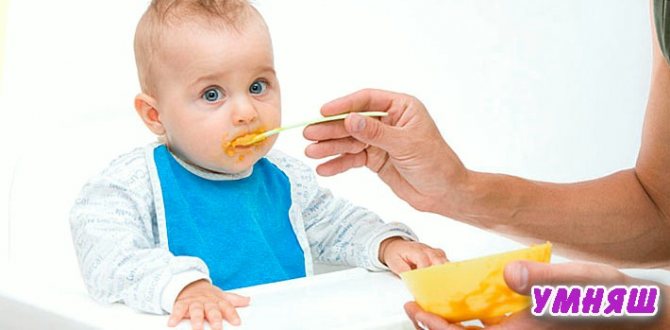
How to understand that the baby is ready
By the age of 1 year, the baby has 6-8 teeth, with which he can already bite and chew food using the gums. The child can cope with small pieces of boiled vegetables and soft fruits, cookies, and chopped meat products.
The baby is able to hold thin pieces of food with his fingers, which allows him to offer food that he can pick up with his hand and put in his mouth. This ability stimulates the development of fine motor skills and teaches the child independent feeding skills. During this period, you should carefully monitor your baby so that he does not put more food in his mouth than he can chew.
After 1 year, chewing teeth gradually erupt, by which time the chewing skill has already been fully developed. Chewing becomes complete at 1.5-2 years, when the mouth already has 16 teeth and the diet consists mainly of solid food.
Doctor Komarovsky advises
The famous pediatrician Komarovsky is trusted by many parents who have many questions about the health and development of the child. In his opinion, this is how children should be taught:
1. Serve a solid dish for lunch and explain that the store no longer has jars of puree. And show that all family members at the table eat solid food.
2. Focus the child’s attention on the dish. Give him the opportunity to “make soup” on his own, allow him to mash boiled vegetables with a fork. Children eat such food, prepared independently, with great pleasure.
3. The result will be that you give the whole delicious piece. For example, marshmallows.
4. Show kids by the example of other children that it is good to eat solid food. You can invite people you know with children who already eat adult food to visit. Looking at them, your tomboy will imitate and eat the same way.
Be attentive to your children, do not miss possible developmental deviations. You can read about when the baby begins to hold his head up by clicking on the link.
What to do if the child is unconscious?
If a toddler has choked on something large enough, for example a bone, cannot breathe and has lost consciousness, then it must be placed on a flat, hard surface. After this, stand next to him or kneel next to him and place one hand on his stomach with your fingers towards his head, and the second on top of it. Press inward and upward so that the stuck object can pop out. Repeat six times, proportioning the force to the age of the victim, then check the airway. To do this, you need to tilt the child's head back, pinch his nostrils and make two calm mouth-to-mouth exhalations. If the chest begins to fall and rise, it means that oxygen has begun to flow. But if the baby does not begin to breathe on his own, assistance should continue to be provided. In an unconscious state, the throat gradually relaxes, so that the chance of removing the foreign body is high.
Useful: Rotavirus infection in a child: signs and treatment
A child who has choked heavily should be seen by a doctor, even if the problem was resolved on their own. There may be some particles left and they need to be removed. It happens that a foreign body or its fragments slip into the lower respiratory tract, to which their mucous membrane responds with inflammation. Swelling appears, breathing becomes difficult, and bronchitis or pneumonia develops. To prevent this from happening, the child should be examined by a professional.
Any child can choke on food or choke on water or milk. An emergency is not the right time to panic. Parents should know what to do in this case, because it depends on them how first aid will be provided.


